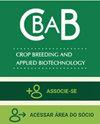Characterization and genetic diversity of Coffea canephora accessions in a germplasm bank in Espírito Santo, Brazil
IF 1.1
4区 农林科学
Q2 Agricultural and Biological Sciences
引用次数: 10
Abstract
The state of Espirito Santo is the major producer of Coffea canephora in Brazil. Knowledge of genetic reserves is fundamental to plant breeding. Therefore, the present study characterized and analyzed the genetic diversity of 600 C. canephora accessions from the germplasm bank of Incaper based on 38 traits evaluated in 24-30-month-old plants. Further, the predominant descriptors or traits were identified, and high phenotypic variability was determined. Genetic distances for the grouped (Gower), quantitative, and qualitative datasets were 0.48, 0.61, and 0.92, respectively, with accessions 76 (Conilon) and 407 (Robusta) being the most divergent ones at Incaper. In clustering using the Tocher optimization method, 30 groups were formed, with three accessions introduced from Epamig s Robusta collection being the most dissimilar ones. Graphical dispersion analysis using the principal coordinate method revealed the predominance of three groups formed by the Robusta, Conilon, and hybrid Robusta × Conilon genotypes.巴西圣托Espírito种质资源库中canephora咖啡的特性和遗传多样性
圣埃斯皮里图州是巴西咖啡的主要生产国。遗传储备知识是植物育种的基础。因此,本研究基于24-30个月龄植物的38个性状,对来自Incaper种质库的600份C.canephora材料的遗传多样性进行了表征和分析。此外,鉴定了主要的描述符或性状,并确定了高表型变异性。分组(Gower)、定量和定性数据集的遗传距离分别为0.48、0.61和0.92,其中76号材料(Conilon)和407号材料(Robusta)是Incaper差异最大的材料。在使用Tocher优化方法进行聚类时,形成了30个群体,其中从Epamig的Robusta集合中引入的三份材料是最不相似的。使用主坐标法的图形分散分析揭示了由Robusta、Conilon和杂交Robusta×Conilon基因型形成的三个群体的优势。
本文章由计算机程序翻译,如有差异,请以英文原文为准。
求助全文
约1分钟内获得全文
求助全文
来源期刊
CiteScore
2.40
自引率
13.30%
发文量
25
审稿时长
6-12 weeks
期刊介绍:
The CBAB – CROP BREEDING AND APPLIED BIOTECHNOLOGY (ISSN 1984-7033) – is the official quarterly journal of the Brazilian Society of Plant Breeding, abbreviated CROP BREED APPL BIOTECHNOL.
It publishes original scientific articles, which contribute to the scientific and technological development of plant breeding and agriculture. Articles should be to do with basic and applied research on improvement of perennial and annual plants, within the fields of genetics, conservation of germplasm, biotechnology, genomics, cytogenetics, experimental statistics, seeds, food quality, biotic and abiotic stress, and correlated areas. The article must be unpublished. Simultaneous submitting to another periodical is ruled out. Authors are held solely responsible for the opinions and ideas expressed, which do not necessarily reflect the view of the Editorial board. However, the Editorial board reserves the right to suggest or ask for any modifications required. The journal adopts the Ithenticate software for identification of plagiarism. Complete or partial reproduction of articles is permitted, provided the source is cited. All content of the journal, except where identified, is licensed under a Creative Commons attribution-type BY. All articles are published free of charge. This is an open access journal.

 求助内容:
求助内容: 应助结果提醒方式:
应助结果提醒方式:


